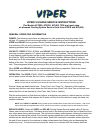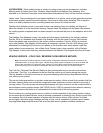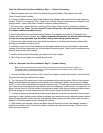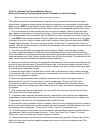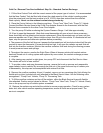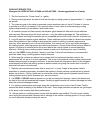Cold Car / Reverse Flow Service Method: Step 3b – Standard Coolant Exchange
1. Fill the New Coolant Tank with the correct amount of the proper type of coolant. It is recommended
that the New Coolant Tank be filled with at least the rated capacity of the vehicle’s cooling system
(plus the prime level) and the best practice is to fill 10-20% more new coolant than the vehicle’s
rated capacity. Never run the onboard coolant storage tanks dry.
2. Place the Control Valves in the following positions: “Pump From” New Tank; “Pump To” Vehicle.
Connect the Black Service Hose to the Cross Flow Adapter closest to the thermostat, with the Red
Service Hose connected to the other Cross Flow Adapter.
3. Turn the pump ON while monitoring the System Pressure Gauge. It will take approximately
15-18 psi to open the thermostat. (Note that some thermostats will open at much lower pressures –
these most likely will be defective and require replacement. Other thermostats may not open until the
pressure reaches over 20 psi.) Never introduce more than 25 psi to the vehicle. If a thermostat will not
open, stop the process and determine problem before proceeding.
4. The pressure of the fluid will drop as it passes the thermostat and will circulate at about half the rate
required to open the thermostat. If pressure builds too high, it will open the radiator cap and fluid will
flow into the overflow container. Monitor the overflow container fluid level during the cleaning process
to avoid pressure issues and spillage.
5. Throughout the service, monitor the Sight Glass. When all cleaner solution/old coolant mixture
has been forced out of cooling system and replaced by new coolant, the coolant exchange process
is complete.
6. After viewing new coolant in sight glass, turn pump OFF and disconnect the Red Service Hose.
The vehicle will be full of new coolant.
7. To provide a clean and easy disconnect process, reverse the hook-up process and reassemble
upper radiator hose to vehicle. By vacuuming the fluid out of the upper hose and top of radiator prior
to disassembly, this step can be accomplished with minimal fluid loss.
8. Remove the overflow container lid and, if needed, vacuum out any remaining dirty fluid utilizing the
flexible pick up tube (included with unit) attached to the Black Service Hose. Use the following valve
arrangement: “Pump From” Vehicle; “Pump To” Processing Tank.
9. To fill the overflow container and top-off the radiator, utilize the Black Service Hose with flexible
tube attached. Position control valves as follows: “Pump From” New Tank; “Pump To” Vehicle. Slowly
turn on the pump and top off vehicle system as needed.
10. Replace the radiator cap and start the vehicle to ensure proper operation. Check for any system
leaks and, after vehicle reaches operating temperature, ensure all fluids are at proper levels. The
service is complete.



